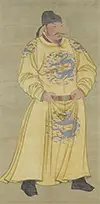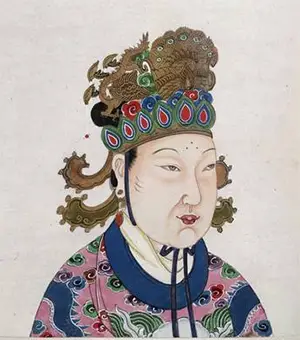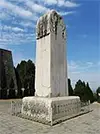Empress Wu was one of China's few female overall rulers. She was an interlude between two parts of the Tang Dynasty.
She was born in 624 into a well-to-do family that lived in Shanxi Province. Her father, Wu Shihuo, served in a high-level government post; her mother was from one of China's most powerful families of the time.
As a young girl, Wu learned history and politics and also knew how to write, both characters and calligraphy. She could  also write poetry, play music, and speak well in public. All of those talents helped her catch the eye of Taizong (right), the Tang emperor; and in 638, the emperor called her to be one of his court companions. She served in that capacity for more than a decade.
also write poetry, play music, and speak well in public. All of those talents helped her catch the eye of Taizong (right), the Tang emperor; and in 638, the emperor called her to be one of his court companions. She served in that capacity for more than a decade.
She was in charge of the royal laundry for a time, then ascended to the post of the emperor's personal secretary, which involved taking part in many affairs of state.
When Taizong died in 649, his ninth son, Li Zhi, succeeded him and took a new name, Gaozong. The new emperor had a wife, Lady Wang, but also had other women that he desired. One of these was Wu, who had found herself sent away to Ganye Temple after Taizong's death. Gaozong had the young woman brought back to court and declared his favor for her.

Controversy enveloped Wu in 654, when she had a daughter who then died quickly. Wu blamed the emperor's wife, Lady Wang, who was eventually blamed for the infant's death because of a large amount of circumstantial evidence. Gaozong divorced his wife and married Wu, who had two very young sons. The emperor named the boys as heirs to the throne.
Gaozong suffered from ill health but still reigned for more than three decades. When he suffered a stroke in 660, Wu Zhao took charge of most of the government. She enjoyed military success, overseeing a dominating victory over Korea in 668.
Gaozong tottered on until 683; when he died, his son Zhongzong became emperor. Both he and his brother Ruizong proved ineffective and found themselves forced from power by Wu Zhao, who, in 690, dispensed with all pretense and declared herself Empress Wu Zetian (the latter name means "Ruler of the Heavens").
During her reign, Empress Wu improved the education system, introduced government reforms, added new characters to the writing system, and improved agricultural practices.
As a powerful woman in a world of much more prevalent powerful men, Wu knew all too well what it was like to be in the minority. She lowered taxes so that peasants could have a chance at succeeding in life and reformed governmental hiring mechanisms so that they did not automatically discriminate against those from the lower classes.
Fearful of being assassinated, the empress had her own secret police and spy network. She suspected a great many people, including members of her own family, perhaps with good reason because Taizong himself took the throne after deposing his own father and later killing him.

The ascension of the empress brought with it a new dynasty, the Zhou, which lasted until Wu herself was deposed, in 704, by her son Zhongzong. She died the following year. A large memorial tablet stands near her tomb but has no inscription, the lone exception in more than two millennia of Chinese rulers.